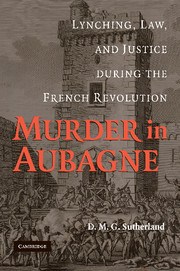Book contents
- Frontmatter
- Contents
- List of Figures
- Preface
- Acknowledgments
- Abbreviations
- Aubagne: An Introduction to the Problem
- 1 Structures and Events
- 2 The Olive Festival
- 3 Aubagne's Universe: Marseille, Aix, and Arles, 1789–1792
- 4 Murders in Provence
- 5 Vigilantism and Federalism
- 6 Federalism
- 7 Terror in a Small Town: Aubagne
- 8 The Revolution of the Antiterrorists: Vengeance, Massacre, and Justice
- 9 The Bande d'Aubagne
- Conclusion
- Appendix
- Sources and Methods
- Index
9 - The Bande d'Aubagne
Published online by Cambridge University Press: 13 August 2009
- Frontmatter
- Contents
- List of Figures
- Preface
- Acknowledgments
- Abbreviations
- Aubagne: An Introduction to the Problem
- 1 Structures and Events
- 2 The Olive Festival
- 3 Aubagne's Universe: Marseille, Aix, and Arles, 1789–1792
- 4 Murders in Provence
- 5 Vigilantism and Federalism
- 6 Federalism
- 7 Terror in a Small Town: Aubagne
- 8 The Revolution of the Antiterrorists: Vengeance, Massacre, and Justice
- 9 The Bande d'Aubagne
- Conclusion
- Appendix
- Sources and Methods
- Index
Summary
The first round of murders in Aubagne was an aftershock of the prison massacres elsewhere. Nor was Aubagne alone in suffering these tremors. Murders or prison massacres occurred in smaller centers like Polyzoan, Lambesc, Eygalières, Noves, Salon, Eyragues, Graveson, Barbentane, Senas, and Roquevaire. In the Basses-Alpes, there were murders of prominent republicans at Manosque and Sisteron.
In the Vaucluse, there were dozens of shootings, stabbings, beatings, and even a decapitation in that terrible summer of the Year III. In Avignon, the trial of the judges of the Popular Commission of Orange inflamed opinion enormously. Every day, angry crowds gathered at the courthouse. Outraged spectators assaulted the prison that held the former judges. All were found guilty and guillotined on the Place du Palais on 8 Messidor (27 June). As their bodies were being transported to the cemetery, the crowd overwhelmed the escort and seized the corpses. They threw them into the Rhône because, in another example of the highly significant gesture of exclusions that dominated the legal and extralegal executions of the period, “the people did not wish the same earth to cover both the victims and their executioners.” The Criminal Tribunal also sentenced a clerk of the Popular Commission to the pillory where the crowd seized and murdered him. They dragged his body through the streets as they had other corpses earlier, and then hurled it into the Rhône as well.
Young toughs with white gloves pinned to their hats terrorized Avignon.
- Type
- Chapter
- Information
- Murder in AubagneLynching, Law, and Justice during the French Revolution, pp. 262 - 284Publisher: Cambridge University PressPrint publication year: 2009

